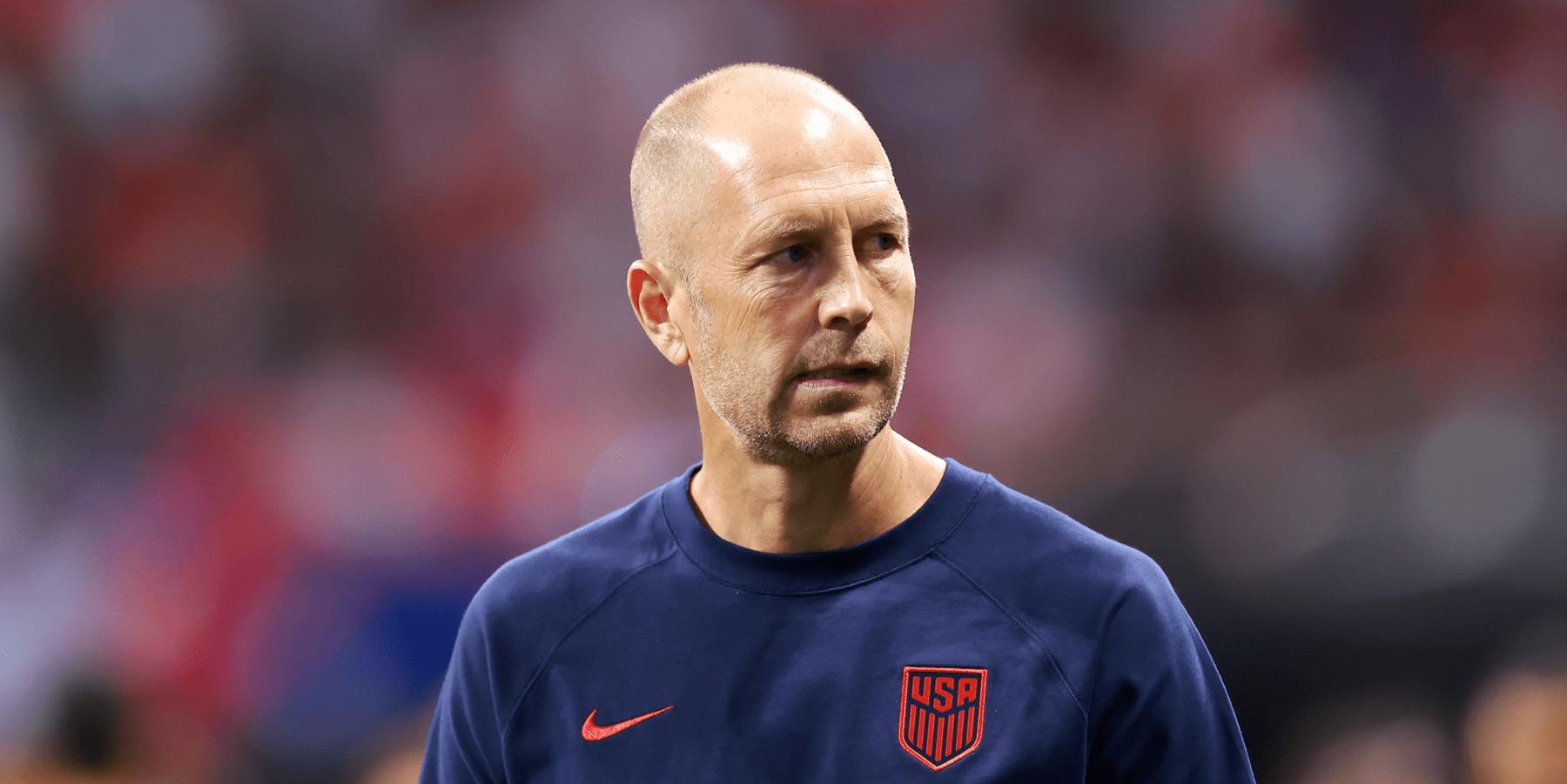Following a 2-1 defeat to Panama, hosts the United States have a tough task ahead of them to stay in the 2024 Copa America. We look at the likelihood of them progressing and the issues that have gotten them here.
The United States’ home Copa America campaign was not supposed to come down to this.
Leading into the tournament, their final Group C game against Marcelo Bielsa’s Uruguay was expected to be a straightforward battle for the top spot, with Panama and Bolivia, ranked 43rd and 84th in the world respectively, deemed unlikely to offer much of a threat.
However, following a 2-0 win over Bolivia, Gregg Berhalter’s side were surprisingly beaten 2-1 by Panama on Thursday, with the hosts ceding control after Timothy Weah’s early red card.
That result has had a big impact on their hopes of progressing, potentially leaving the U.S. requiring a win against an in-form Uruguay next week. And perhaps most critically for the United States, it’s against an in-form Uruguay that still hasn’t technically clinched the group or even a spot in the knockout rounds because of the 0.2% chance of the United States and Panama pulling off big wins that would put Uruguay out on goal difference. Goal difference is the first tiebreaker at Copa America, unlike the Euros where head-to-head points come first.
The story of the USA’s Copa America campaign to date has been one of unfulfilled potential, a lack of decisiveness in attack despite strong finishing from Folarin Balogun, and a struggle to change things on the fly. It might sound familiar to England supporters, who watched the Three Lions rather limp through to the Euro 2024 knockout rounds.
Before a ball was kicked at this year’s tournament, the Opta supercomputer gave the USA a 64.5% chance of reaching the last eight. After Thursday’s defeat and leading into Friday’s Group D games, they now have just a 45.9% probability of advancing, as anything less than a victory over Uruguay – who have won two from two and presumably won’t rest on their laurels as they bid to clinch the top spot – will leave them needing a favour from Bolivia in their match with Panama.
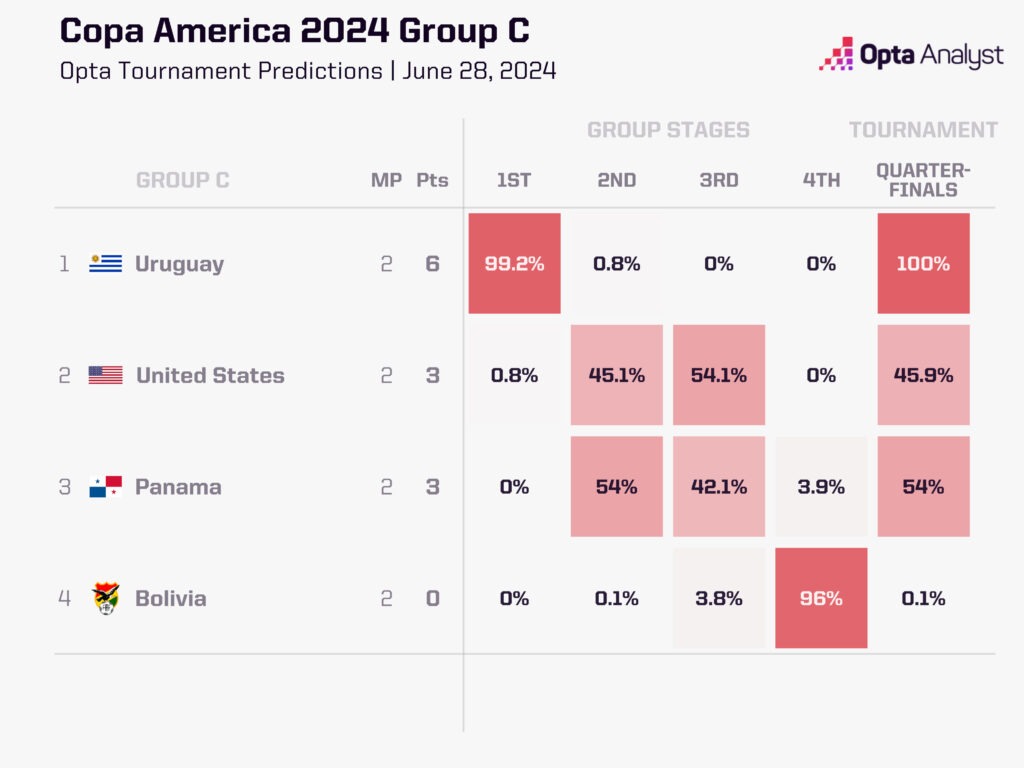
Though the USA could still top the group with a win, third place (54.1%) is now viewed as their most likely final position, which would represent a monumental failure at a tournament viewed as a dress rehearsal for a home World Cup in 2026.
The USA were clearly superior in their opening 2-0 win over Bolivia, firing off 20 shots worth 2.51 expected goals (xG) and recording 35 touches in the area to their opponents’ one.
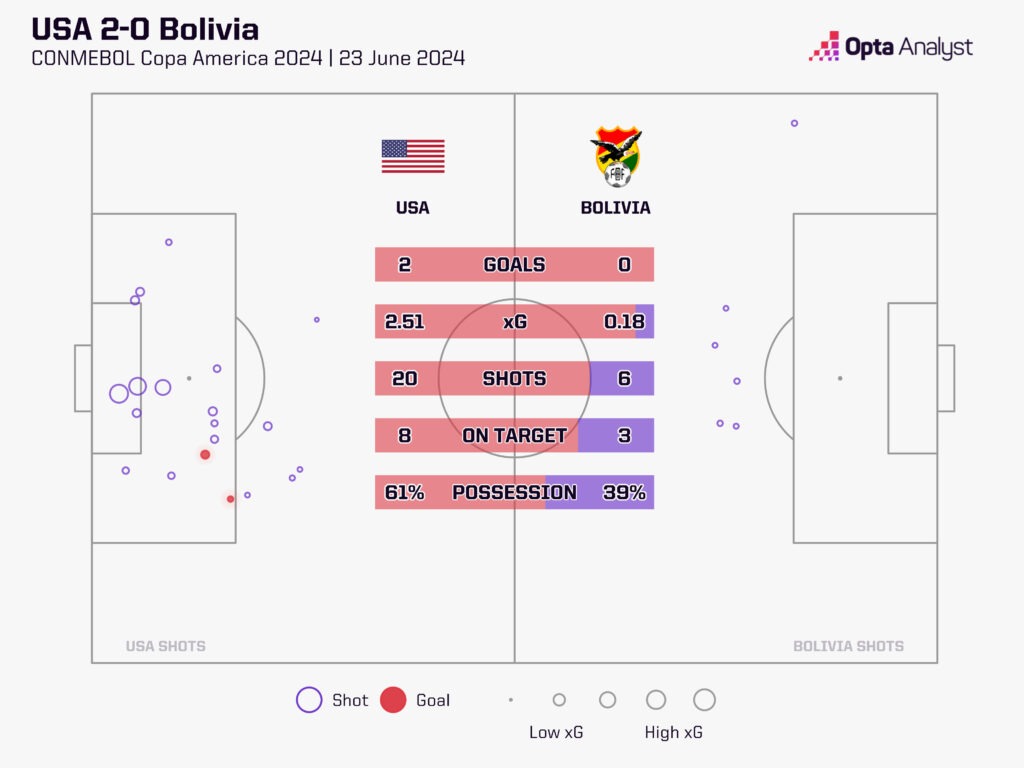
It was at times an impressive showing, but the level of competition absolutely has to be considered, particularly after Uruguay beat Bolivia 5-0 on Thursday night.
While Weah’s early red card – the result of a petulant push to the back of Panama player Amir Murillo’s head – put them in a difficult position in Thursday’s second group match, that incident did not necessarily have to precipitate such a collapse.
Indeed, four minutes after Weah’s exit, their frustration turned to elation as Balogun fired a brilliant left-footed finish in off the woodwork from the edge of the area.
However, the 10-man USA gave up control of the game after assuming the lead, which was wiped out within four minutes by César Blackman.
Home fans would probably have expected Panama to enjoy more of the ball while a man up, but the sheer extent to which they dominated will have been alarming. Panama finished the match with a 73.6% possession share, the highest figure any Concacaf team has managed in a Copa America match on record (since 2011), and the eighth-highest overall.
From the 19th minute onwards, the U.S. completed just three passes into the Panama penalty area, recording a dismal 59.4% passing accuracy throughout the match – comfortably the worst figure at the tournament so far.
Though they won plaudits for their dynamic approach at the 2022 World Cup in Qatar, Berhalter’s side can look uncomfortable when tasked with exercising control. That was certainly the case on Thursday, and while there’s the 10-man asterisk to again point to, there were signs of it against Bolivia as well as things grew stale for extended periods even early in the match when the U.S. only led by a goal.
That could be in part because they’re missing Sergiño Dest’s dynamism coming up the right side and in his absence have settled for a more traditional right-back in Joe Scally. Or it could be midfield complications. For all the possession the U.S. had against Bolivia (60.7%), Weston McKennie was alarmingly absent for the first 45 minutes.
At the World Cup, it was a given that the effective trio of Tyler Adams, Yunus Musah and McKennie would be named to Berhalter’s XI. Adams hasn’t played much since due to hamstring injuries, and Musah didn’t see the pitch against Panama after subbing on for Adams to start the second half against Bolivia. That trio is yet to play together at this tournament.
The team managed only six shots against Panama, as Panama set a new national record for the lowest amount of attempts faced in a Copa America match. Their previous low was 12 shots, against both Bolivia and Argentina in 2016.
Two of the four defeats the United States have suffered as hosts in major tournaments have come against Panama.
Berhalter’s changes – particularly the decision to sacrifice Giovanni Reyna for an additional defender in Cameron Carter-Vickers – did nothing to stem the tide.
By the time he changed tack by bringing on Josh Sargent for Tim Ream in the 86th minute, it was too late, with José Fajardo’s close-range finish proving decisive.
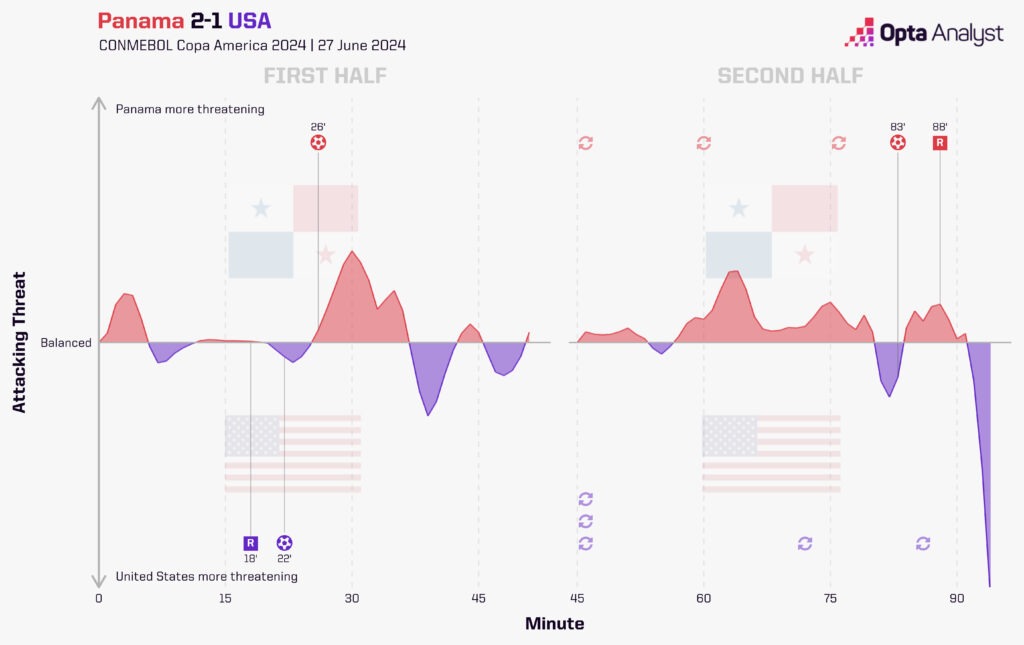
While the USA spent long periods sitting off Panama when down a man, they still had one huge chance to restore their advantage at 1-1, but substitute Ricardo Pepi saw his uncontested header kept out by Orlando Mosquera in the 81st minute. Two minutes later, it was 2-1 the other way.
Pepi has only played 43 minutes off the bench at this year’s Copa, yet his cumulative xG figure of 2.27 is the highest of any player at the tournament. The five players directly below the goalless Pepi in the xG charts – Kendry Páez, Lautaro Martínez, Darwin Núñez, Salomón Rondón and Facundo Pellistri – have all netted at least once.
While the PSV striker could be forgiven for his wastefulness in the Bolivia match, when the United States had already ceded control before his second-half introduction, his form is starting to become a major worry.
The fact that Pepi was introduced in place of goalscorer Balogun in Atlanta has brought further scrutiny upon Berhalter. The Monaco forward is one of just four men to net more than once at this year’s Copa America, and only the second USA player to score in successive Copa matches, after Clint Dempsey netted in three straight at the 2016 tournament.
Both of Balogun’s goals have been pinpoint finishes from the left side of the penalty area, coming despite his xG total for the tournament standing at just 0.34. For context, that is a lower figure than that recorded by Harry Kane through England’s first two matches at Euro 2024 (0.48), and the Three Lions’ struggles in the chance-creation department have been well documented.
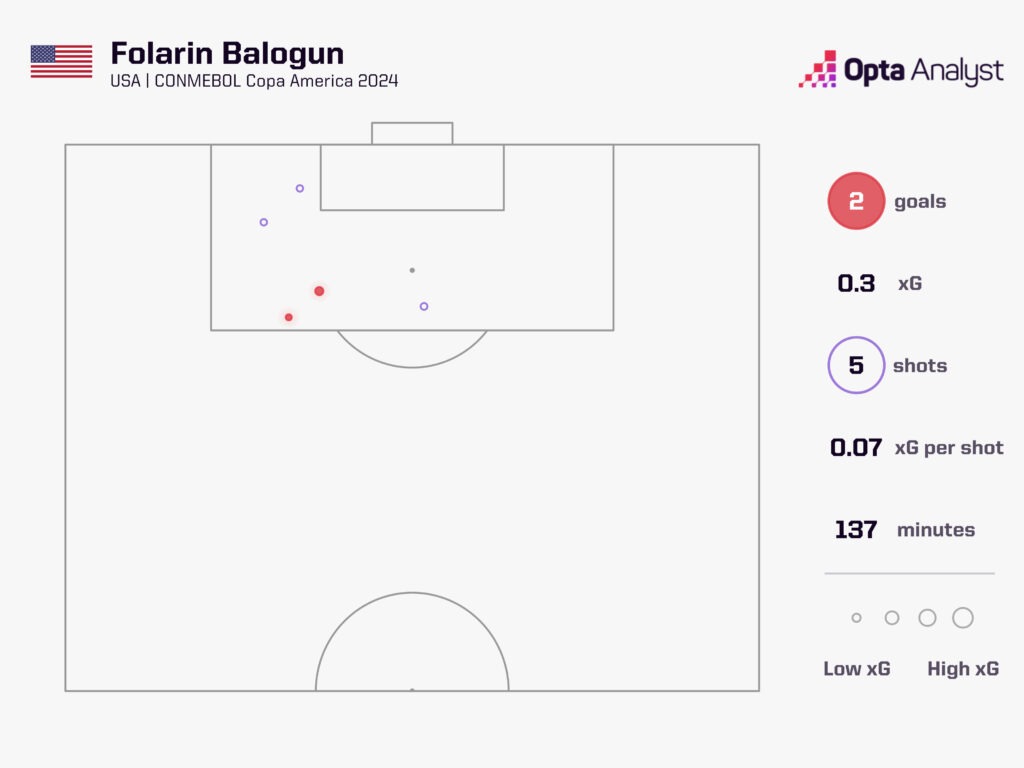
Convincing Balogun to switch allegiance from England in 2023 was considered a major coup for the USA, with his decision coming at the end of a season in which he plundered 22 goals while on loan at Reims from Arsenal.
At present, however, they aren’t fully utilising their star striker, who has averaged just 4.0 touches in the opposition penalty area per 90 minutes at this tournament, having averaged 8.0 per 90 in Ligue 1 last term.
Berhalter will hope Uruguay’s expansive approach gives Balogun space to attack on Matchday 3, but without any level of control or the ability to play through the thirds, the striker will always be peripheral.
Similar failings have not yet cost England at Euro 2024, a set of lacklustre opponents and the 24-team format ensuring a group-stage exit was never really on the cards.
With one of South America’s form teams next up and no second chances for third-place finishers at the Copa America, the same may not be true for the United States.
Enjoy this? Subscribe to our football newsletter to receive exclusive weekly content. You should also follow our social accounts over on X, Instagram, TikTok and Facebook.
